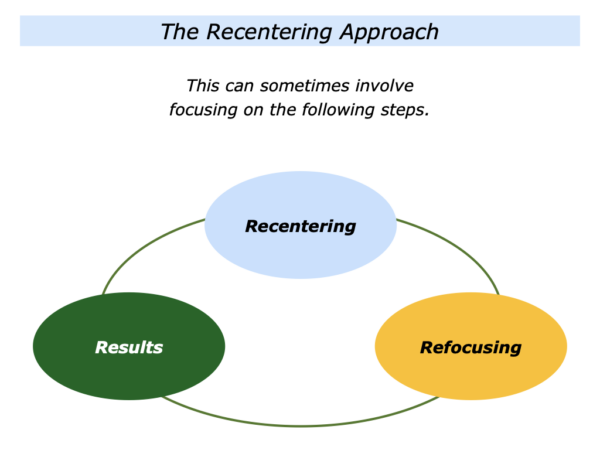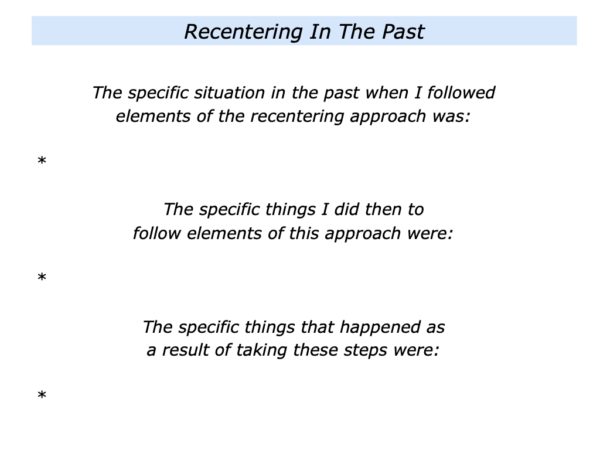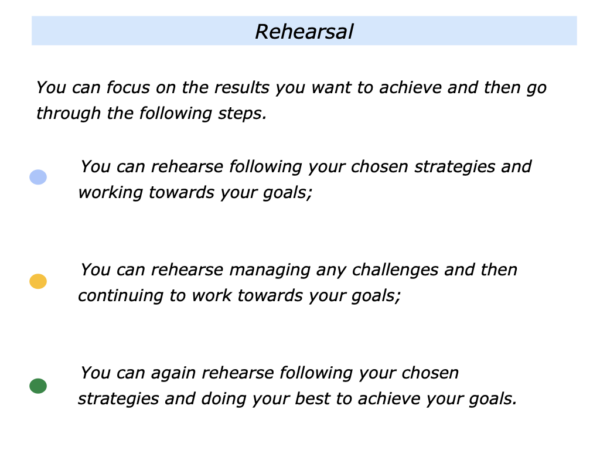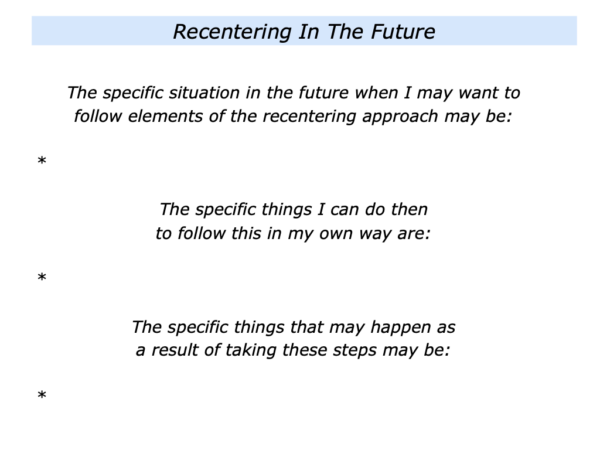
Different people use the recentering approach in different situations. They may do so when reflecting on what is important in life, recovering from setbacks or shaping their future. It involves going through the following steps.
They take time to rest, reflect and recenter. They reconnect with the core principles they want to follow. Sometimes they take the opportunity to revitalise themselves. They then refocus on the future.
They explore the possible ways forward. Clarifying the real results they want to achieve, they rehearse pursuing their chosen strategy. Moving into action, they then do their best to deliver the desired results.
(Please note. This piece uses the US spelling recentering rather than the English recentring.)
Some people also follow elements of this approach when recovering after a setback. One person expressed this in the following way.
“I go through the stages of rebounding, refocusing and aiming to deliver the desired results.”
Whatever they call it, this approach often involves recentering and clarifying what they want to do in the future. They then aim to do their best to achieve their goals.
Let’s return to your own life and work. Looking back, when have you followed some elements of the recentering approach? This could have been in your personal or professional life.
You may have done this when been feeling vulnerable – such as being ill or after experiencing a setback. You may have done so when taking time to reflect on your values and explore your future possibilities.
What did you do to reflect, recentre and revitalise yourself? What did you do to revisit your inner compass and core principles? What did you then do to shape your future?
If you wish, try tackling the exercise on this theme. This invites you to describe what you did to follow some elements of the recentering approach.

Imagine that you want to follow some of these principles in the future. Let’s explore how you can take these steps.
Recentering
The first step is to take time to recenter. Sometimes it is possible to set aside time to rest, reflect and revitalise yourself. Sometimes it calls for buying time to think in the midst of a hectic activity or environment.
You will follow your own ritual for recentering. You may aim to find a quiet place, do deep breathing or find another way to relax. Choosing to reflect, you may go through some of the following stages.
Reconnecting With
Your Core Principles
Some people use the time as an opportunity to reconnect with their core principles. Depending on the situation, different people do this in different ways. Some ask themselves the following questions when faced by a challenge or when looking into the future.
“What are the things that I believe are important in life? What are the core principles I want to follow in my life or work? What are the reasons why I believe it is important to follow these principles?
“How can I follow these principles in the future? What will be the pluses and minuses of following these principles? Bearing these in mind, what is the route I want to follow?”
Imagine that you want to take this approach at some point in the future. Sometimes it can be useful to think ahead and revisit your inner compass. This can help you to act decisively when it matters.
If you wish, try tackling the exercise on this theme. This invites you to complete the following sentences.
My Core Principles
The core principles I want to
follow in my life or work are these.
I want:
* To …
* To …
* To …
Good organisations also take time to recenter. They do this to ensure they are building on their core principles. They believe this approach is more likely to help them to achieve sustainable success.
Some organisations take a different approach. During the Covid-19 crisis, some rushed into the suggested process of recovery, reimagining and aiming to get results. They wanted build a better future, but there was a potential problem.
Rushing to fill a gap in the market, they may or may not have been building on their principles. This might produce short-term wins. But over the long term they may find themselves far away from their core strengths.
Revitalisation
Some people use the recentering time as an opportunity to revitalise themselves. Different people do this in different ways.
Some do this on a physical level. They rest, sleep or find other ways to revitalise the body. Some do it on a psychological level. They focus on things that give them positive energy. Some do it on a philosophical level. They revitalise their soul by focusing on their spirit and strengths.
Revitalisation has several meanings. These include the following: to give new life, to reinvigorate, to regenerate, to renew. The revitalisation process can also involve building on the best of the past and generating energy to shape the future.
Imagine that you have done some of these things. It will then be time to move on to the next step.
Refocusing
This step involves refocusing on what you are going to do next and rehearsing how to make it happen. This could be to tackle a challenges, achieve a goal or do another activity. Let’s explore these themes.
Refocusing On What You
Are Going To Do Next
Some people have a ritual they follow to refocus their attention on shaping the future. Bearing in mind the principles they want to follow in their life, they may then explore their following themes.
What am I going to do next? What is the task I want to do, the challenge I want to tackle or the goal I want to achieve? What are the real results I want to achieve – the picture of success?
What are the key strategies I can follow to give myself the greatest chance of success? How can I anticipate and manage any challenges? What else can I do to increase the chances of achieving success?
Imagine that you have taken this approach and have settled on your chosen route forwards. It can then be useful to take the next step.
Rehearsal
Great workers often rehearse following their chosen strategy. Different people do this in different ways. Here is one approach that you may wish to consider.

Great teams also rehearse pursuing their strategy. One Premier League football team in England, for example, makes sure that everybody knows their part in implementing the game plan. Here is how the team’s captain explained the approach.
“Every player knows the team’s playing strategy and what we want to achieve. They know exactly what they are supposed to do in the process.
“They also know the movements of the other players. This makes it second nature to know where to pass the ball.
“Every player knows what to expect during the week. After finishing the training on one day, we are told what we will be doing in training the next day.
“Everybody can then prepare properly for the training. This provides a framework where we can apply our talents to win matches.”
Results
Imagine that you have gone through the recentering process and feel revitalised. You have also refocused and rehearsed pursuing your strategy.
You can then follow your ritual for clicking into action. Being fully present, you can follow your principles, delivering consistently high standards and aim to do superb work.
One approach is to follow your chosen rhythm. It is then to keep reading reality, keep improving and doing your best to deliver the desired results. Sometimes you may also reach the goal by adding that touch of class.
Let’s return to your own life and work. Looking ahead, can you think of a situation where you may want to go through the stages of recentering, refocusing and delivering results?
You may aim to do this when managing a crisis, overcoming a setback, tackling a specific challenge or doing another activity. You may do this when acting in your role as a parent, friend, educator, coach, trusted advisor, leader or in another professional role.
What can you do then to buy time to recentre and reconnect with your inner compass? How can you raise your sights and refocus? How can you follow your rhythm and deliver the desired results?
If you wish, try tackling the exercise on this theme. This invites you to complete the following sentences.







Leave a Reply